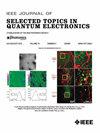Correlation of Hemodynamic Responses Measured on Human Head by Diffuse Correlation Spectroscopy and BOLD MRI
IF 5.1
2区 工程技术
Q1 ENGINEERING, ELECTRICAL & ELECTRONIC
IEEE Journal of Selected Topics in Quantum Electronics
Pub Date : 2025-07-22
DOI:10.1109/JSTQE.2025.3589169
引用次数: 0
Abstract
In this study, first we compared the performance of continuous wave diffuse correlation spectroscopy (cw-DCS) and time domain diffuse correlation spectroscopy (td-DCS) in assessing the dynamic of scatterers during series of measurements on two-layered phantoms. Then, we compared the blood flow index (BFI) measured by DCS techniques and evaluated its correlation with the blood oxygenation level–dependent (BOLD) signal measured by magnetic resonance imaging (MRI) during respiratory challenges, including breath-holding (BH) and hyperventilation (HV). We found a good agreement between the amplitude changes of BFIs and BOLD signal in response to BH and HV maneuvers. Moreover, we observed positive correlations between the BFIs and BOLD signal changes in response to these respiratory challenges. Notably, during BH, BFI changes preceded the BOLD signal (on average by about 2.7 s), while during HV, the responses were nearly simultaneous (delay about 0.2 s). These results support the potential of DCS techniques as a complementary tool in assessing cerebral hemodynamic. However, to make these optical techniques practically useful, further improvements in hardware—especially in coherence length and pulse width of the td-DCS laser source is necessary.漫射相关光谱和BOLD MRI测量人头血流动力学反应的相关性
在这项研究中,我们首先比较了连续波漫射相关光谱(cw-DCS)和时域漫射相关光谱(td-DCS)在评估两层幻像中散射体动态的性能。然后,我们比较了DCS技术测量的血流量指数(BFI),并评估了其与呼吸挑战期间磁共振成像(MRI)测量的血氧水平依赖(BOLD)信号的相关性,包括屏气(BH)和过度通气(HV)。我们发现bfi信号的振幅变化与BOLD信号对BH和HV机动的响应具有很好的一致性。此外,我们观察到bfi和BOLD信号变化在应对这些呼吸挑战时呈正相关。值得注意的是,在BH期间,BFI的变化先于BOLD信号(平均约2.7 s),而在HV期间,响应几乎同时发生(延迟约0.2 s)。这些结果支持DCS技术作为评估脑血流动力学的补充工具的潜力。然而,为了使这些光学技术在实际应用中发挥作用,进一步改进硬件,特别是在td-DCS激光源的相干长度和脉宽方面是必要的。
本文章由计算机程序翻译,如有差异,请以英文原文为准。
求助全文
约1分钟内获得全文
求助全文
来源期刊

IEEE Journal of Selected Topics in Quantum Electronics
工程技术-工程:电子与电气
CiteScore
10.60
自引率
2.00%
发文量
212
审稿时长
3 months
期刊介绍:
Papers published in the IEEE Journal of Selected Topics in Quantum Electronics fall within the broad field of science and technology of quantum electronics of a device, subsystem, or system-oriented nature. Each issue is devoted to a specific topic within this broad spectrum. Announcements of the topical areas planned for future issues, along with deadlines for receipt of manuscripts, are published in this Journal and in the IEEE Journal of Quantum Electronics. Generally, the scope of manuscripts appropriate to this Journal is the same as that for the IEEE Journal of Quantum Electronics. Manuscripts are published that report original theoretical and/or experimental research results that advance the scientific and technological base of quantum electronics devices, systems, or applications. The Journal is dedicated toward publishing research results that advance the state of the art or add to the understanding of the generation, amplification, modulation, detection, waveguiding, or propagation characteristics of coherent electromagnetic radiation having sub-millimeter and shorter wavelengths. In order to be suitable for publication in this Journal, the content of manuscripts concerned with subject-related research must have a potential impact on advancing the technological base of quantum electronic devices, systems, and/or applications. Potential authors of subject-related research have the responsibility of pointing out this potential impact. System-oriented manuscripts must be concerned with systems that perform a function previously unavailable or that outperform previously established systems that did not use quantum electronic components or concepts. Tutorial and review papers are by invitation only.
 求助内容:
求助内容: 应助结果提醒方式:
应助结果提醒方式:


